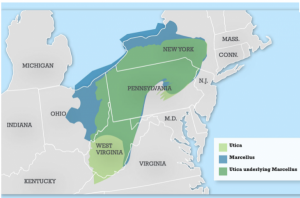Editorial Title: “Marcellus Boom”
Charleston WV Gazette Newspaper Editorial, Sunday, November 16, 2014
Last week — on the same day that Alpha Natural Resources announced closure of another southern West Virginia coal mine and the loss of 36 more miner jobs — news reports said a Texas gas firm will pay $100 million in up-front bonuses to some Northern Panhandle landowners for their Marcellus Shale drilling rights, and their future royalties could climb $500 million more.
That’s a thumbnail glimpse of what’s happening to West Virginia’s economy. Southern coalfields are fading as rich seams become exhausted and cheap natural gas grabs markets. Northern gas fields are blossoming, opening a bright promise of energy and chemical jobs.
Moundsville lawyer Jonathan Turak represents a coalition of 500 families in Marshall and Ohio counties. He helped negotiate a deal in which Tug Hill Operating of Fort Worth will pay the landowners $100 million immediately for a five-year option to drill deep horizontal wells that employ “fracking” to release gas pockets. If wells are drilled, Turak said, future royalties to the property owners could add $400 million to $500 million more.
“I think that our community has not yet come to grips with the enormity of what’s likely to occur here,” the lawyer said. “It’s a wave that is growing, and it is far from having crested, and it’s going to sweep through the Ohio Valley like no other wave that has ever descended down through our valley.”
The snowballing gas boom will spur jobs of all sorts — accountants, insurance agents, doctors, restaurants, hotels, etc. — he exuberated. “There is so much opportunity. … I think it’s going to transform this community.”
Tug Hill already has drilled 750 Marcellus Shale wells in Pennsylvania and West Virginia since 2007.
A major offshoot of Marcellus drilling is the prospect that chemical plants will sprout around northern West Virginia to turn gas derivatives into plastics. Although modern, automated plants need fewer workers, the job potential remains large.
We hope the Marcellus boom sweeps West Virginia toward hopeful times, but there are some cautionary notes.
Some experts warn that Marcellus wells will deplete fairly quickly, so benefits may not be as long-lasting as boosters promise. Also, state regulators must guard against pollution and damage that accompany industrial extraction, a lesson West Virginia should have learned well by now.
>>>>>>>>>>>>>>
Commentary – Notice this last sentence, the lesson WV should have learned by now. Actually, it is primarily the Governor and Legislature that should have already seen the land disturbances, water pollution, stream siltation and sedimentation, hillside subsidence, public noise, plus air pollution from vents, leaks, flares, fires and explosions. The trucks are destroying the roads, creating traffic delays and accidents, polluting neighborhoods, and transporting hazardous and toxic materials.
After studying these serious impacts, one finds public health issues and worker health issues. The oil and gas industry is now recognized as the most dangerous major industry in the US.
The loopholes granted to the oil and gas industry during the Bush/Cheney administration still stand in spite of all the issues these loopholes present. Shouldn’t there be a federal ban on drilling and fracking until these loopholes are closed? That would be only the fair and reasonable thing to do, if there was any fairness and reasonableness to be had? The Gazette editorial is caught up in euphoria with only a dangling sentence, to hold regulators responsible for what is the responsibility of the US Congress as well as the WV Governor and WV Legislature! DGN


{ 2 comments… read them below or add one }
I would add that everyone should be talking about radioactivity in the drill cuttings: radium-226 (which turns to radon gas very quickly and has a half-life of 1600 years), radium-228, thorium, and strontium.
These are carcinogens and found abundantly in the Marcellus stratum. These are currently being sent to municipal landfills that are only equipped to take household trash.
We do not seem to have an industrial landfill here, but the 255,000 tons of drill mud in Wetzel County alone in 2013 is enough to give one pause. Our regulators need to do a better job of handling this very dangerous material, and soon!
There is at least one landowner in the state who has offered his farm as a site for a landfill of this type. Try as he might, he can’t find anyone to develop it, or any legislators who are interested in supporting its use, but this is the next wave. Get ready !
If we don’t control for this radioactivity, it is going to get the better of us, and we likely won’t know until it is too late. It has already been going on now for ten years and we know of cases where there have been releases into the public water supply.
Who is studying this? What conclusions can we draw if we are not collecting the data?
Don’t know whose well it is, but the gas well near Mt. Morris, Greene County, PA, east of I-79, is still lighting up the sky after about a week. Not as noticeable, but still there.
I wonder how much gas they’ve burned in this flaring phase.
(Mt. Morris is also on the Mason-Dixon Line, between Morgantown, WV, and Waynesburg, PA.)